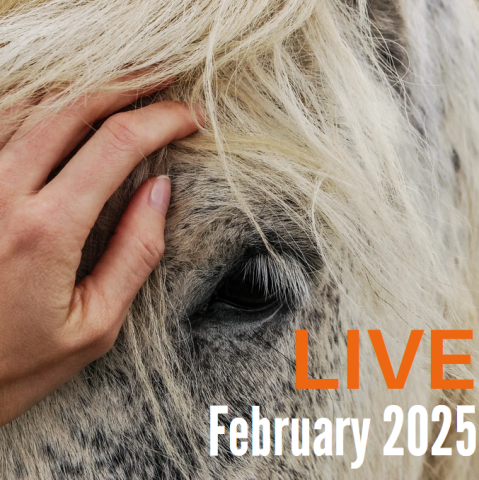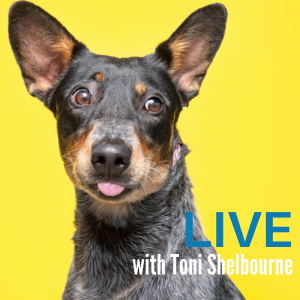Search Results
Your search for WhatTellingtonMethod returned 14 categories and 47 items
Items
About Us > Our Teachers > Meet Our Instructors
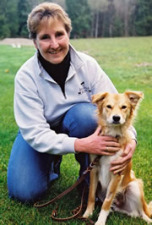
Debby Potts
For as long as she can remember, Debby knew she would spend her life working with animals. She began to live the TTouch® philosophy of creative problem solving even before she had any idea this would be her life’s work; she was extremely allergic to anything covered with hair or fur!
Of course she dreamed of having a dog. Her turtle named Herman and her canary, Tangie, were wonderful but it wasn’t the same as thoughts of walks around the block with her very own dog. One day her parents learned that poodles didn’t shed. Shoni, a silver miniature poodle, soon became her best friend.
Debby’s interest in health and well-being was sparked by her childhood companion animals, and continued with her becoming one of Oregon's first board certified veterinary technicians. She grew up breeding and showing horses, which gave her an extensive background into working with many different breeds and disciplines of horses. A horse born with severe neurological damage initially brought Debby to Tellington TTouch® Training in 1984 after the veterinarians had done all they could to help the filly. The amazing progress Spirit made inspired Debby to use the Tellington techniques to improve the lives of animals and their people on a physical, mental and emotional level.
Debby’s passion for helping people and animals in a fun, positive and creative way is evident in the many workshops and trainings she teaches every year. She has been a popular speaker at various international conferences including the Association of Pet Dog Trainers and the International Symposium on Rescue Dogs. She established TTouch® in Japan and oversees the Tellington TTouch® Companion Animal Practitioner Training there.
From the beginning, Debby has used the TellingtonMethod to help humans as well as animals. Today Debby frequently works with people to help them reduce pain, recover from illness or injury and to improve mobility and function. She finds the Tellington work and philosophy to be an important part of helping people to find balance and well being in their lives. She often says, “TTouch® isn’t just what I do, it’s who I am.” TTouch® philosophy has strongly influenced her life and that of her family. Her two wonderful sons were raised with these concepts and often asked their mom for TTouch® when they had bumps and bruises.
Debby travels much of the year teaching trainings and working privately with individuals in North America, Europe, South Africa and various parts of Asia. She lives near Portland, Oregon with her human and animal family. For more information about Debby visit her website www.IntegratedAnimal.com.
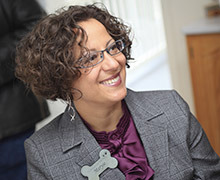
Maryse Perreault
As long as she can remember, Maryse, was always fascinated by the oneness of life and nature. As a child, following her father’s teachings, she would wander in silence in the forest, in a sort of meditative state, ‘’listening to the sound of life’’ as her father and grandfather would say. She became fascinated by interspecies bonds and relationships, including the human and companion animal bond.
What always piqued her interest was trying to understand the other and trying to establish a bond of trust without using words. As a result of this, she would unexpectedly find herself being touched by vivid emotions forming relationships that are sometimes so simple and sometimes very complex.
Later, two events brought TTouch on her path. Her dog was diagnosed with Addison’s disease, and she met with Lucie Leclerc, who was then a TTouch practitioner and assistant. These life events gave her the curiosity and interest to learn more about TTouch and it ended up completely changing her life path and career goals.
She continued her TTouch training until she became a TTouch practitioner. Up until this point, she had received her degrees in Geology and Communication but was also working, in her spare time, as a dog trainer using positive reinforcement and as an animal-assisted activities practitioner and teacher.
From then on, she dedicated her life to teaching TTouch to numerous groups of people with different backgrounds within the animal field like groomers, shelter employees, dog trainers, and animal-assisted activities practitioners, for example. She was also an active mentor to both French and English-speaking students.
She wrote articles in French for blogs, also translating numerous documents and training, and teaching online classes as well.
In her desire to better understand the TTouch method and develop her self-awareness abilities, she went on to explore the world of somatic education. She amongst other methods, explored Tai Chi, Qi Gong, Karate, the Feldenkrais Method… She ended up earning a degree in the field and now also teaches voice guided somatic work inspired by Moshe Feldenkrais in Québec, Canada.
That work, along with the TTouch work, influenced and changed the way she teaches animal-assisted activities/therapy work. She has worked with dogs, rabbits and other small animals from shelters and helping them manage their stress, anxiety and nervousness has been a growing passion from the very beginning.
As a companion animal Tellington TTouch instructor, Maryse, sees again and again how animals, like humans, possess the resources that allow them to express their full potential and their relational skills.
She is proud to partake in the changes humans are putting forward in order to collaborate and to create authentic, supportive, and respectful alliances with their pets.
For more information about Maryse, visit her website www.essenceetalliances.com or contact her directly at ttouchquebec@gmail.com.
About Us > Research & Studies
Horse 1999 EPM. Neurological Study
Tellington TTouch® as a Complement in the Rehabilitation of Horses with EPM and Neurological Deficits
The manual has been given to several veterinarians for the use of their clients and has been found very effective. Additional study and documentation required.
A study of the rehabilitation of horses with neurological deficits, using TTEAM, started through the efforts of Dr. Mark Meddleton and his wife, Becky. Becky's horse, Jewel, was severely affected by Equine Protozoal Myeloencephalitis (EPM) and Dr. Mark was trying all the forms of experimental medication. During the times that the medication seemed to be working, Becky decided to try TTEAM to rehabilitate Jewel. Becky applied her basic knowledge of TTEAM and was impressed by what she was observing with Jewel.
Becky and Mark came to a TTEAM workshop at Galisteo Creek Farms in April, 1999 to learn more and to talk with Linda to see if TTEAM would cooperate in a study of rehabilitating horses with EPM. Becky explained to the group that initially she had thought that only the ground exercises would help, but after talking with TTEAM Instructor Carol A. Lang, she tried the TTouch and realized it too was a key element.
To initiate the study, Linda and Carol met with Dr. Mark and Becky at a client's farm. A neurological exam was performed by Dr. Mark on three horses. TTEAM techniques were shown the horse's owner and Dr. Mark set up a basic schedule of rehabilitation with instructions the owner was to follow. In a few weeks, Carol met with Dr. Mark and Becky at this client's farm. Dr. Mark reexamined the horses and both he and the owner agreed that improvement had been made. Carol taught the owner more TTEAM techniques and Dr. Mark scheduled another evaluation of the horses.
In June of 1999, Dr. Mark, Becky and Carol worked with Jewel and Mark's horse, Dugan, who also had been diagnosed with EPM. Dr. Mark did a neurological exam of each horse. Then, as they did TTEAM and TTouch® with both horses, Dr. Mark, Becky and Carol discussed which techniques were working, the timing of the sessions, the sequence of TTouch® and the work in the TTEAM Confidence Course. They also made a first draft of a checklist for the owners to keep track of their horses rehabilitation program.
Carol accompanied Dr. Mark and Becky on visits to at least three clients who had horses with neurological difficulties. Each owner was shown TTEAM techniques and Becky recommended the rehabilitative process. Dr. Mark's scheduled follow-up neurological checks in order to track progress. Becky reported that the percentage of improvement of the trial horses was very high and that the owners were very satisfied with the results.
To continue the development of a protocol that Dr. Mark planned to present to the AVMA, Carol met with Dr. Mark and Becky and TTEAM Practitioner, Kirsten Henry several times over the next year. They filmed a video demonstrating how to do TTEAM techniques specifically for rehabilitation of horses with neurological deficits and developed a modified Confidence Course.
They did many trials with TTEAM techniques, in particular the use of wand and lead, the TTEAM body wrap and TTouches.
Carol prepared a booklet of TTEAM techniques to be distributed to participants of the study. Dr. Meddleton reviewed this booklet and made suggestions from his perspective as a veterinarian.
Hoping to receive a grant, Dr. Mark presented this protocol to a veterinary conference in the fall of 2000. The evaluation and advice offered about their study gave Dr. Mark and Becky new insights and direction. However, Dr. Mark's veterinarian practice was expanding so much that their time for continuing this study was curtailed.
In March, 2002 Dr. Mark reported to Carol that he could not proceed with the study of a protocol for EPM/neurologically impaired horses. He offered to share his and Becky's work with any veterinarian that Linda might find who would be interested in continuing.
We know that TTEAM has been very effective in helping horses rehabilitate from neurological deficits. We offer this booklet as a guide to TTEAM Practitioners and others who will use TTEAM and TTouch to facilitate their horses' rehabilitation.
Carol A, Lang, TTouch Instructor
Santa Fe, New Mexico
Purchase the Booklet in our Shop.
NOTE: TTEAM is an acronym of "Tellington TTouch® Equine Awareness Method." Since this article was written, the brand name for all the facets of the TTouch® organization is Tellington TTouch®.
Events
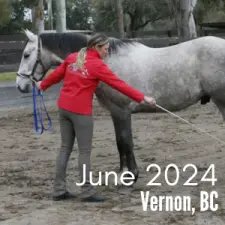
Develop Your Horse’s Potential
Do you want to learn simple, easy and horse friendly exercises and techniques that can transform your horse’s posture, behaviour and overall performance?
Do you have a horse who is coming back into work or has past trauma or habits from poor training, injury or just long-term patterns of tension?
Would you like to learn low-stress, effective, safe and innovative techniques and exercises that can be integrated into what you already know and do?
Do you want to enhance the relationship you have with your horse?
This weekend course will provide an overview to identifying functional, weight carrying posture and provide bodywork, ground work, and innovative exercises to help you offer your horse discover new possibilities of movement, balance and posture with long lasting benefits.
Discover how to train your eye to notice dysfunctional patterns of posture, muscle development and areas of tension so you can start being more aware of how your handling and training is positively, or negatively, impacting your horse’s physical well-being.
Learn simple, effective, and non-invasive body work techniques to help encourage relaxation, breathing and trust. These exercises can be used by horse owners of all level and no previous anatomy knowledge is required.
Mindful, low-stress, functional ground work exercises in hand and over poles will give you beneficial ways to help your horse find new patterns of movement that will not re-create tension patterns caused by old habits.
In addition to bodywork and groundwork techniques, Mandy will introduce TTouch Body Wraps and SURE FOOT Equine Stability Pads as additional, horse guided tools that can transform postural patterns at a deep, long lasting level.
Can count to credit for Tellington TTouch Practitioner credits.
Included in tuition is access to our Online Course – “Happy Horse Course: Tellington TTouch Method”. $79.94 USD VALUE
Snacks and refreshments are included.
Learn more about the Facility and Accommodations.
For cancellations made more than 30 days in advance of the training, a refund will be given minus a $100 administration fee. No refunds are possible for cancellations less than 30 days prior to the start of the training, unless we can fill your spot. In some cases credit can go towards subsequent events.
We recommend that you purchase flight and hotel insurance for each event for which you register.
$425.00
All prices are quoted in Canadian Dollars
ttouch.caTellington TTouch® for You & Your Horse
Live Interactive Sessions for you & your horse
Dates: Saturdays – February 1, 8th, 15th & 22nd.
Time: 9:00am – 11:30am (PST) or 17:00 – 19:30 (GMT)
Cost: $249.00
Certification Credits: 8
Between the sessions you will take what you have learned and practice it with your own horses. Take video for specific feedback to share in the next class so you can refine and improve your technique. (Live sessions are recorded in case you cannot make the live time)
LIVE ZOOM sessions for further guidance and discussion of course material. Between the sessions you will take what you have learned and practice it with your own horses. Take video for specific feedback to share in the next class so you can refine and improve your technique.
Join us for a supportive, interactive learning experience that will give you the understanding and skills to start making a difference in your horse’s performance, balance, trust and well-being right away!
Enjoy the logical, linear, learning of Online Learning PLUS 10 hours of inspiring and interactive learning with 10 hours of ZOOM sessions, in 2.5 hour weekly sessions.
What You Will Learn
- This course guides you through several components of the Tellington TTouch Method for Horses.
- Discover the kind, empathetic, heart-centered, philosophy that is at the core of our approach.
- Understand how to “see your horse with new eyes” through non-judgmental, rational, methods of observation and understanding of behaviour.
- Learn the cornerstone of the TellingtonMethod, the TTouch Bodywork, simple, non-invasive and easy to learn equine bodywork that relieves tension, improves posture, increases awareness and enhances trust.
The online portion of the course includes:
- 8 Learning Lesson Modules each with a variety of focused topics
- Easy to follow mind maps and “how-to” video
- 24/7 Instant access to all materials
The LIVE interactive portion of the course includes:
✳️ 10 hours of LIVE, virtual learning in an intimate, supportive, group
✳️ Personalized coaching for your and your horse’s specific goals or challenges
✳️ A dedicated WhatsApp group for all participants for any mid week queries or discussion
✳️ Private Facebook page where the recordings of the zoom sessions will be uploaded.
Full Details and Registration
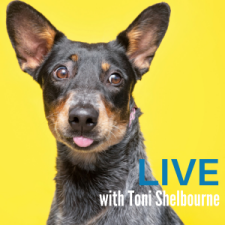
Interactive & Online: Anxious Dogs – Understanding and Managing Anxiety
Beginning on October 6th, join Tellington TTouch Instructor, Animal Behaviourist and Author, Toni Shelbourne as she helps you unlock the keys to understanding and supporting your anxious dog.
We all want a calm, confident canine companion. Consistent training, an enriched , low-stress lifestyle, adequate exercise and a good diet all contribute to helping our dogs feel their best; but what do you do when you come across a dog who still struggles with anxiety? As with people, anxiety is a complex issue that cannot necessarily be helped with a “one sized fits all approach” or simply additional training or exercise. This course is designed to help TTouch Practitioners and practitioners in training, rescue workers, dog owners and canine professionals gain a comprehensive understanding of anxiety in dogs.
You will acquire practical techniques in the Tellington TTouch Training method to support and manage anxious dogs. This course combines theoretical knowledge with practical strategies to empower participants in providing a nurturing and anxiety-free environment for their own canine companions, dogs in their care or clients dogs.
During the two, 2 hour live-stream sessions, Toni will guide you through the steps of understanding and then addressing your dog’s anxiety in a gentle, supportive and integrative way. These sessions are recorded for future viewing and you have lifetime access to all content.
This course include hours of informative, helpful lectures as well as easy to follow videos demonstrating specific techniques.
Course Outline:
What is anxiety.
Canine Communication.
Safe dog handling.
Working with the over-aroused anxious dog.
Working with the catatonic or shy dog.
What can we add to enhance our work.
What you will learn!
- Gain a comprehensive understanding of dog anxiety and its various forms.
- Learn practical strategies to reduce anxiety and create a calm environment.
- Develop skills in confidence building and calmness in dogs.
- Discover additional support options and interventions for severe cases.
- Promote the overall well-being and happiness of yours or your client’s dog.
Note: While this course provides valuable insights and techniques, it’s essential to consult with a veterinarian or professional dog behaviourist for personalized guidance in managing your dog’s anxiety.
Course Instructor:
Tellington TTouch Companion Animal Instructor Toni Shelbourne brings a wealth of experience with many different species and modalities. Toni is also an Accredited Animal Behaviourist based in the UK and has the following qualifications.
- Diploma in Canine Behaviour (ISCP Dip.Canine.Prac.)
- Tellington TTouch Instructor
- Real Dog Yoga Instructor
- Full Member of INTODogs
- Full Member of the International Companion Animal Network (ICAN)
- Senior Instructor for Dog Training College
- Author
- Over three decades of experience working with animals
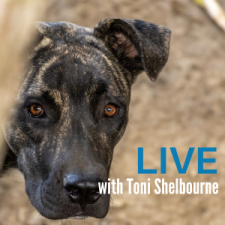
Interactive & Online: Anxious Dogs – Understanding and Managing Anxiety
Beginning on February 11th, join Tellington TTouch Instructor, Animal Behaviourist and Author, Toni Shelbourne as she helps you unlock the keys to understanding and supporting your anxious dog.
We all want a calm, confident canine companion. Consistent training, an enriched , low-stress lifestyle, adequate exercise and a good diet all contribute to helping our dogs feel their best; but what do you do when you come across a dog who still struggles with anxiety? As with people, anxiety is a complex issue that cannot necessarily be helped with a “one sized fits all approach” or simply additional training or exercise. This course is designed to help TTouch Practitioners and practitioners in training, rescue workers, dog owners and canine professionals gain a comprehensive understanding of anxiety in dogs.
You will acquire practical techniques in the Tellington TTouch Training method to support and manage anxious dogs. This course combines theoretical knowledge with practical strategies to empower participants in providing a nurturing and anxiety-free environment for their own canine companions, dogs in their care or clients dogs.
During the two, 2 hour live-stream sessions, Toni will guide you through the steps of understanding and then addressing your dog’s anxiety in a gentle, supportive and integrative way. These sessions are recorded for future viewing and you have lifetime access to all content.
This course include hours of informative, helpful lectures as well as easy to follow videos demonstrating specific techniques.
Course Outline:
What is anxiety.
Canine Communication.
Safe dog handling.
Working with the over-aroused anxious dog.
Working with the catatonic or shy dog.
What can we add to enhance our work.
What you will learn!
- Gain a comprehensive understanding of dog anxiety and its various forms.
- Learn practical strategies to reduce anxiety and create a calm environment.
- Develop skills in confidence building and calmness in dogs.
- Discover additional support options and interventions for severe cases.
- Promote the overall well-being and happiness of yours or your client’s dog.
Note: While this course provides valuable insights and techniques, it’s essential to consult with a veterinarian or professional dog behaviourist for personalized guidance in managing your dog’s anxiety.
Course Instructor:
Tellington TTouch Companion Animal Instructor Toni Shelbourne brings a wealth of experience with many different species and modalities. Toni is also an Accredited Animal Behaviourist based in the UK and has the following qualifications.
- Diploma in Canine Behaviour (ISCP Dip.Canine.Prac.)
- Tellington TTouch Instructor
- Real Dog Yoga Instructor
- Full Member of INTODogs
- Full Member of the International Companion Animal Network (ICAN)
- Senior Instructor for Dog Training College
- Author
- Over three decades of experience working with animals
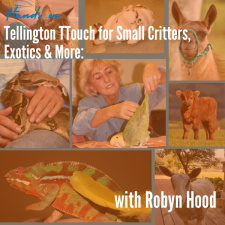
Hands On -Tellington TTouch® for Small Critters, Exotics and More
Introduction to Tellington TTouch for Multispecies Care – Cross Training for Your Skills
Date: April 9, 2025
$167.97 approximately the equivalent to £125 GBP
Discover a Revolutionary Approach to Animal Well-being and Connection
Join us for an immersive one-day workshop exploring the Tellington TTouch Method, a gentle, hands-on technique that transforms the way we interact with animals. Designed for animal enthusiasts, caregivers, and professionals, this session provides a unique opportunity to learn how to improve well-being, behavior, and cooperation while deepening trust and communication between humans and animals.
What You’ll Learn:
- Tellington TTouch Bodywork: Master the foundational hands-on techniques that promote relaxation, reduce stress, and improve function for animals of all ages and species.
- Multispecies Focus: While we’ll focus on dogs, cats, and people, you’ll also learn how to adapt these techniques for a variety of animals, including small farm animals, reptiles, alpacas, parrots, and more.
- Tailored Solutions: Understand how to customize TTouch for each animal’s unique needs, rather than relying on a one-size-fits-all approach.
This workshop is perfect for:
- Pet guardians looking to enhance their relationships with their animals.
- Professionals in animal care, including massage therapists, trainers, and veterinarians.
- Animal lovers eager to cross-train their skills and learn techniques for a wide range of species.
No prior experience is needed, and the techniques are easy to learn and apply. By the end of the day, you’ll have the tools and confidence to make a meaningful difference in the lives of the animals you care for—and in your own life, too!
View Details and Register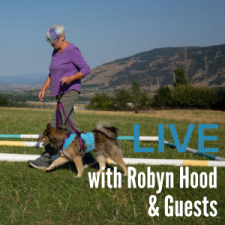
Interactive & Online Tellington TTouch® for Dogs
Immersion Series with Robyn Hood & Guests – 2024/25
$999.00
The ultimate learning experience! With over 86 hours of learning opportunities, supportive Whatsapp group, multiple instructors for varied learning and lifetime access to all recordings and a comprehensive online course.
Join Tellington TTouch Method Instructor, Robyn Hood, as well as other guest instructors, and develop a deep level of understanding and skill that will transform how you understand and work with dogs.
Enjoy the logical, linear, learning of online learning along with the inspiring and adaptive format that includes 30 hours (60 if you choose to watch both sessions) of small, LIVE, Zoom sessions – all recorded for your convenience and on-going learning.
Full Details and Registration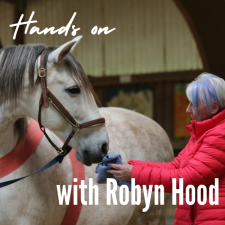
Hands On -Tellington TTouch® for Horses
Transform Your Connection with Horses Through the Tellington TTouch Method
Date: April 10 & 11, 2025
$325.00 approximately the equivalent to £250 GBP
Are you looking for new and innovative ways to understand and work with horses?
Whether you’re a professional trainer, equestrian enthusiast, or horse owner, the Tellington TTouch Method for Horses Workshop offers a fresh, effective, and low-stress approach to building trust, improving performance, and fostering well-being—both on the ground and in the saddle.
What You’ll Learn:
This hands-on workshop is designed to equip you with a wide range of practical skills that you can use to better understand and connect with horses.
View Details and RegisterInteractive & Online: Anxious Dogs – Understanding and Managing Anxiety
Dates: Saturdays – February 1st & 22nd, 2025
Time: 16:00 – 18:00 GMT/ 11:00 – 13:00 EST – via Interactive Zoom Sessions (recorded for repeated viewing)
Cost: $179.99
Included Content: Easy to follow, 6 lesson self-paced course! Includes many hours of video lectures and how-to video demonstrations.
Academy Credits: 4
Beginning on February 1st, join Tellington TTouch Instructor, Animal Behaviourist and Author, Toni Shelbourne as she helps you unlock the keys to understanding and supporting your anxious dog.
We all want a calm, confident canine companion. Consistent training, an enriched , low-stress lifestyle, adequate exercise and a good diet all contribute to helping our dogs feel their best; but what do you do when you come across a dog who still struggles with anxiety? As with people, anxiety is a complex issue that cannot necessarily be helped with a “one sized fits all approach” or simply additional training or exercise. This course is designed to help TTouch Practitioners and practitioners in training, rescue workers, dog owners and canine professionals gain a comprehensive understanding of anxiety in dogs.
You will acquire practical techniques in the Tellington TTouch Training method to support and manage anxious dogs. This course combines theoretical knowledge with practical strategies to empower participants in providing a nurturing and anxiety-free environment for their own canine companions, dogs in their care or clients dogs.
During the two, 2 hour live-stream sessions, Toni will guide you through the steps of understanding and then addressing your dog’s anxiety in a gentle, supportive and integrative way. These sessions are recorded for future viewing and you have lifetime access to all content.
This course include hours of informative, helpful lectures as well as easy to follow videos demonstrating specific techniques.
Full Details and Registration
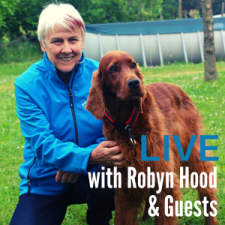
Interactive & Online Tellington TTouch® for Dogs

Join Tellington TTouch Method Instructor, Robyn Hood, as well as other guest instructors, and develop a deep level of understanding and skill that will transform how you handle and train dogs.
Enjoy the logical, linear, learning of online learning along with the inspiring and adaptive format that includes 36 hours of small, LIVE, Zoom sessions – all recorded for your convenience and on-going learning.
This course is the ideal option for anyone seeking an integrative and compassionate approach to understanding, handling and training dogs. Whether you are a professional dog trainer or dedicated dog guardian, this course will provide you with an incredible framework of philosophical understanding, observational skills, bodywork techniques, leash work exercises and innovative tools that can make what you already do well, be even better.
The Tellington TTouch for Dogs: Immersion Series can serve as your core curriculum for Tellington TTouch Online Academy Certification credits but is also a fantastic learning opportunity for those wanting to add to what they already do well or expand their knowledge and skill set in canine wellness and management.
Register and gain access to an extensive, clearly laid out and detailed online course covering the material you would learn in at least two, 5 day hands on sessions. This course can be done at YOUR OWN PACE, before or after the LIVE sessions.
Beginning in February enjoy, the first of twelve, 3 hour immersion session that will leave you inspired, empowered and excited to
Between sessions you will work on specific skills and assignments, if you are working towards Certification. Sessions are recorded for future viewing or should you have to miss a live class. Each session will be taught by Robyn or another one of our wonderful TTouch Instructors.
Enjoy the comforts of home, with your animal at ease, in this small, intimate group setting. Robyn will help coach you through specific concerns you may have and give you the tools to enhance your dog’s well being.
This course can count towards the Tellington TTouch Practitioner certification program for dogs. It is also suitable for dog guardians who are interested in the method to enhance their relationship. All levels of experience and areas of interest are welcome.
Students will have access to online material to cover at their own pace. The online portion of learning consists of a logical, linear, “Tellington TTouch for Dogs – Level 2”, which can be accessed at any time.
The online portion of the course includes:
- The FULL Tellington TTouch for Dogs Practitioner Course: Each consisting of several specific topics.
- Hours “how-to” videos and lectures about each specific concept and exercise
- Study Quiz Questions at the end of each section for your own learning
- Lesson video assignments, to be completed by those pursuing certification
- 24/7 access to all materials
The LIVE interactive portion of the course includes:
- TWELVE 3 hour sessions of learning in an intimate, supportive, group setting over the span of 6 months
- Class recordings for future viewing & review
- Access to an interactive group chat and discussion page.
- Expert feedback about your own animals
- In class assistants co-teaching and supporting the group’s learning and questions.
Payment plan available, please email ttouch@shaw.ca for information.
ttouch.ca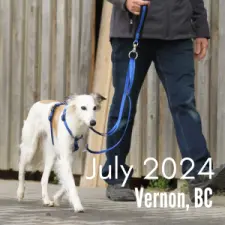
Hands On - Tellington TTouch® for Dogs
Want a calm, confident canine companion?
Looking for the skills to have more enjoyable, relaxing walks on leash?
Maybe you just want to add to your existing skills?
Enjoy the positive, fun filled learning environment that looks at dog training in an all encompassing, whole, way. This workshop can serve as an introduction to the Tellington TTouch Method for Dogs (and other Companion Animals) and build and refine the skills of more experienced students.
Professionals dog trainers and dedicated dog guardians alike will benefit from the variety of practical techniques and unique approaches learned in this class! Add layers of knowledge and skill to what you already to well and discover new ways of understanding and handling that you can integrate into your current program to achieve remarkable results.
During the session you will learn, develop and build on the fundamentals of Tellington TTouch Bodywork, Leash work, and Observation skills.
These skills will empower you with a variety of innovative techniques and exercises to help address the most common issues confronting dog owners, trainers, and other professionals; in a forward thinking, low-stress, positive manner.
This is an ideal method to help enhance positive dog training modalities. Bring your own dog or work with one at the course. There may be an opportunity to work with other species, such as horses, in a safe, confidence building way.
Can count to credit for Tellington TTouch Practitioner credits (8 or 12 credits), suitable for new and returning students.
Tuition
3-Day: $775 plus 5% GST
EARLY BIRD (Ends December 31, 2023) $650 plus 5% GST
5-Day: $1175 plus 5% GST
EARLY BIRD (Ends December 31, 2023) $950 plus 5% GST
Included in this course is our Online Course – “Tellington TTouch for Dogs – An Introduction”. $49.94 USD VALUE
Snacks, lunch and refreshments are included in the price.
Learn more about the Facility and Accommodations.
For cancellations made more than 30 days in advance of the training, a refund will be given minus a $100 administration fee. No refunds are possible for cancellations less than 30 days prior to the start of the training, unless we can fill your spot. In some cases credit can go towards subsequent events.
We recommend that you purchase flight and hotel insurance for each event for which you register.
All prices are quoted in Canadian Dollars.
ttouch.ca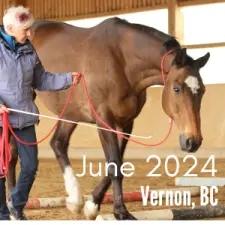
Hands On - Tellington TTouch® for Horses
Are you seeking news way of understanding or working with horses?
Would you like to learn low-stress, effective, safe and innovative techniques and exercises that can be integrated into what you already know and do?
Do you want to enhance the relationship you have with your horse?
Discover how the Tellington TTouch Method will improve performance, well-being, and behavior while enhancing the relationship with your horse on the ground and in the saddle.
This intensive hands-on course will give the tools of observation, bodywork, groundwork, and an introduction to riding concepts that will help you understand and communicate with every horse you work with.
In addition to Tellington TTouch principles we will be exploring the use of Wendy Murdoch’s “Surefoot Equine Stability Program” with a variety of Surefoot Pads and touch on Peggy Cummings’ Connected Riding concepts for body-awareness exercises that can be taken into everyday life, in and out of the saddle.
Enjoy the positive, fun filled learning environment that helps you understand and connect with horses in an all encompassing, whole, way. This workshop can serve as an introduction to the Tellington TTouch Method for Horses or as a way to build and refine the skills of more experienced students.
Choose from 2 different course options:
3 day introductory option for students new to the work and looking to add some tools to their everyday handling
5 day intensive option for students looking to deepen their understanding and refine their skills. The 2 extra days can be tailored to individual interests and learning needs.
Can count to credit for Tellington TTouch Practitioner credits suitable for new and returning students
Tuition (2 Options)
3-Day: $755 plus 5% GST (8 credits)
EARLY BIRD (Ends December 31, 2023) $650 plus 5% GST
5-Day: $1175 plus 5% GST (12 credits)
EARLY BIRD (Ends December 31, 2023) $950 plus 5% GST
Included in tuition is access to our Online Course – “Tellington TTouch for Horses – An Introduction”. $49.94 USD VALUE
Snacks, lunches and refreshments are included.
Learn more about the Facility and Accommodations.
For cancellations made more than 30 days in advance of the training, a refund will be given minus a $100 administration fee. No refunds are possible for cancellations less than 30 days prior to the start of the training, unless we can fill your spot. In some cases credit can go towards subsequent events.
We recommend that you purchase flight and hotel insurance for each event for which you register.
All prices are quoted in Canadian Dollars
ttouch.ca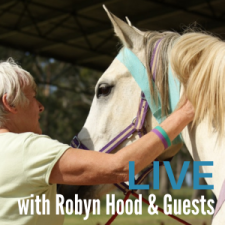
Interactive & Online Tellington TTouch® for Horses
Immersion Series with Robyn Hood & Guests
Join Tellington TTouch Method Instructor, Robyn Hood, as well as other guest instructors, including special sessions with Linda Tellington-Jones, and develop a deep level of understanding and skill that will transform how you understand, handle and train horses.
This course is the ideal option for anyone seeking an integrative and compassionate approach to horse training and management. It will provide you with an incredible framework of philosophical understanding, observational skills, bodywork techniques, groundwork exercises, innovative tools, and work under saddle that can make what you already do well, be even better; all while developing a deeper, more trusting relationship.
Enjoy the logical, linear, learning of online learning along with the inspiring and adaptive format that includes 36 (up to 72 with both classes) hours of small, LIVE, Zoom sessions – all recorded for your convenience and on-going learning.
$999.00
Dates: Saturdays starting September 28, 2024
(Enrollment is open throughout this time period)
Time: 8:00 – 11:00 PT/ 16:00 – 19:00 GMT via Interactive Zoom Sessions
(Recorded in case you miss a session!)
AND/OR (students may choose which session they attend)
Saturdays for Australia: 9:00 – Noon Sydney time/ Fridays: 14:00 – 17:00 PT
Full Details and Registration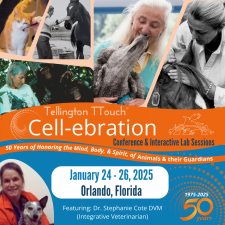
CELLebration Learning 3-Day Conference & Interactive Workshops
Celebrating 50 Years of the Tellington TTouch Method in 2025!
In 1975, Linda Tellington-Jones introduced a groundbreaking approach to influencing behavior, performance, and wellbeing in animals with the Tellington TTouch Method. In 2025 we are thrilled to celebrate 50 years of this revolutionary work!
Even though our October 2024 in-person "Cell-ebration" event was disrupted by hurricane Milton, we’re excited to transform this challenge into an opportunity:
The 2025 Tellington TTouch “Cell-ebration” Learning Conference & Interactive Workshop Sessions have been reimagined, revitalized, and ready to inspire with a completely new format!
This exciting in-person event brings together a community of passionate animal lovers for a blend of learning, sharing, hands-on practice, break out sessions, and meaningful connections.
Mornings will feature engaging lectures, including an inspiring keynote from Dr. Stephanie Cote, DVM, who integrates TTouch, Cranial Sacral Therapy, and other holistic techniques in her veterinary practice.
Afternoons will be dedicated to interactive workshop labs, where you can apply new techniques, refine existing skills, and receive personalized feedback.
Event Details:
Location: Crowne Plaza Hotel
304 West Colonial Drive
Orlando FL 32801
888-295-7563
Dates: January 24-26, 2025, Conference & Banquet
Schedule:
CELL-ebration: Friday January 24th
9:00 - 12:30 Presentations
12:30 – 2:00 Lunch at the Hotel included in tuition.
2:00 - 5:00 Interactive workshops
CELL-ebration: Saturday January 25th:
9:00 - 12:30 Presentations
12:30 – 2:00 Lunch at the Hotel included in tuition.
2:00 - 5:00 Interactive workshops
6:30-8:00 Banquet dinner (not included in tuition)
CELL-ebration: Sunday January 26th:
9:00 - 12:30 Presentations
12:30 – 2:00 Lunch at the Hotel included in tuition.
2:00 - 5:00 Interactive workshops
Note: Program details subject to change.
Fans of TTouch who are not Practitioners or have not taken any trainings, are welcome to attend the full conference.
Event Highlights
Presentations:
- TTouch & Proprioception for Dogs & Horses – Rachel Jackson
- TTouch in Rehabilitation – Karin Freiling
- Experiencing Flower Essences, Acupressure and TTouch with applied Kinesiology – Kathleen Aspenns
- TTouch Success Stories: Extreme Physical Deficits – Sanju Ramachandran
- How TTouch brings light to the cells as a form of healing communication / theory and practice – Elinor Silverstein
- TTouch Behavior Insights for Cats – Toni Shelbourne
Interactive Workshops:
- Refining & Expanding TTouch Skills with Linda Tellington-Jones
- Fascial Integration & Body Wraps with Robyn Hood
- TTouch & Cranial Sacral Therapy with Stephanie Cote & Sally Morgan
- Advanced Concepts for Dogs & Horses with Robyn Hood
- Feldenkrais Awareness Through Movement (ATM) Session
- Round Table Discussions on successes, challenges, and strategies
Participants will be grouped by experience level, creating a dynamic learning environment for both beginners and seasoned practitioners.
Join us for this extraordinary gathering as we "Cell-ebrate" 50 years of changing lives, one TTouch at a time, while honoring Linda Tellington-Jones and our dedicated teachers worldwide.
Note: Program details subject to change.
Incentive:
Bring a friend to our in-person conference (who was not previously registered to attend) you will receive an incredible bonus – of a 30-minute consultation, via Zoom, with Linda Tellington-Jones herself ($200 value)!
Payment options.
Fees: $595 if paid in full when you register
or
you can opt to pay in installments of 3 payments of $211 each (a total of $633), 1st payment due at time of registration, 2nd payment on December 6th and 3rd payment on January 3rd (the last 2 payments will be charged automatically on those days unless you contact our office with different instructions)
Tuition includes the conference and lunches. It does NOT include the Saturday evening banquet dinner.
Special Registration Fees for the CELLebration:
• Daily attendance: $245 per day (includes lunch).
• Banquet: $85 (3 course meal plus coffee and tea)
How to Register
- Below – scroll to the bottom to register and to make a payment.
- Call our office to pay with your Visa, MasterCard, American Express, or Discover card
Cancellation Policy:
Tellington TTouch Training reserves the right to cancel the CELL-ebration and trainings if necessary, because of circumstances beyond our control. In this case all deposits, tuitions and the processing fees will be refunded.
We recommend that you purchase trip insurance for your flight, hotel, etc.
Participant Cancellation Policy:
Any cancellation made more than 45 days before the start of the event will incur a $150 administrative cancellation fee. The remaining amount you have paid will be refunded to you.
For any cancellations made within the 45-day window before the event begins, whatever monies you have paid are nonrefundable, unless you are able to find a substitute participant to take your place.
Lodging
Tellington TTouch has reserved a block of rooms at the Crown Plaza Hotel at the following group room rates (The room block is under Tellington TTouch Training):
$149 plus tax in a Two Queen or King Bedroom
(Two Double Queen Beds or a King Bed with a comfortable sitting area, 48” flat screen, and workspace. A wet bar, mini refrigerator, Keurig coffee maker and full-size microwave adorns the kitchenette area. This suite sleeps 2 to 4)
Group rates include the following for overnight guests:
- Free Wireless Internet Access in all rooms
- Outdoor Pool and Hot Tub daily open from 7 AM – 11 PM
- On-Site Self-Parking – Reduced rate of $10 + tax per day
- 24-Hour Fitness Center
- 24-Hour Business Center
- Bite Bistro & Wine Bar 7 AM – 10 PM
- EV- car charging station on site
- Service Animals are accepted – no other animals allowed
- Free Hotel shuttle within 3 miles of the hotel (closest Grocery store less then 1 mile away -Publix)
Method of Reservations:
Individual reservations can be made online:
Tellington TTouch Training Reservation Link
If you need assistance, you can call Central Reservations: 888-295-7563.
(For International callers use: 407-843-8700)
Please refer to Group Reservation: Tellington TTouch Training
Check In Time: 3:00 PM Check Out Time: 11:00 AM
Please note: Reservations by attendees must be received on or before Monday, December 23rd, 2024 (the “Cutoff Date” for our room block). Reservations received after the Cutoff Date will be confirmed on a space-available basis at prevailing rates.
Please view additional Amenities at the hotel:
www.ihg.com/crowneplaza/hotels/us/en/orlando/mcooa/hoteldetail/amenities
Airports: Orlando International Airport (MCO) about 13 miles to the hotel
Shuttle: We have not been able to locate any airport shuttle but there are Uber, Lyft and Taxies. Please research your preferred option.
Things You Should Know About Orlando
Orlando is one of the most popular travel destinations in the United States.
Some interesting websites:
www.visitorlando.com
worldstrides.com/blog/2017/07/10-fun-facts-orlando/
theculturetrip.com/north-america/usa/florida/articles/15-things-to-know-before-visiting-orlando-florida
Weather:
The average weather in Orlando, Florida at the end of January is mild and comfortable, with temperatures ranging from the 40s to 70s°F
Our Method for > Horses > Attend a workshop > Read More
The Touch That Teaches
In the 1980s, Equus Magazine dubbed Tellington TTouch® Training "The Touch That Teaches" and said participants will learn how to see and embrace their horse as an individual and through observation, patience and TTouch®, find the best ways to assist it in its training.
The second T in TTouch stands for "Trust" and building trust is what we aim for since it is the foundation on which everything else rests. With trust, horses learn to achieve enhanced levels of physical, mental and emotional balance.
Who Should Attend?
- Professionals of every level and from all disciplines, as well as amateurs, can benefit from learning a training philosophy and methodology devoted to working with horses using empathy instead of force - down to the cellular level. Linda's approach focuses on working with horses' minds and intelligence as much as with their body. The same is true of her work with riders.
Why Should You Attend?
- To improve your horse's rideability and performance without stress using holistic and humane groundwork, bodywork and ridden work from the TellingtonMethod and Tellington TTouch® Training.
- To create a long term training program that will help you develop a horse that is confident, willing, mentally and physically healthy, and capable of meeting your training goals regardless of discipline.
- To enhance, repair or deepen your relationship with your horse through the Tellington twin philosophies of "Change Your Mind & You Can Change Your Horse" and "Change the Posture and Change the Behavior."
What Will You Learn?
- Participants will learn how to identify, soothe and resolve discomfort in horses' bodies using TTouch. With the Tellington special ground exercises called the Playground for Higher Learning, they will learn how to help horses develop better patience, balance and suppleness as well as increase their confidence and self-reliance. They will find out why, when and how to enhance their horse's performance under saddle with the Promise Wrap, Liberty Ring, Balance Rein and Lindell, and why, when and how to ride bridleless and more.
- On day one, participating horses and riders will be assessed under saddle to determine which of the TTouches, the Playground for Higher Learning exercises and Tellington riding equipment can be helpful.
- Over the next two days Linda will teach specific TTouches and Tellington techniques appropriate to each horse's situation.
- Participants will be broken into small groups and will practice with the horses under Linda's close supervision and with the help of her experienced team of instructors.
- Participants will also experience TTouch and the Promise Wraps for themselves. Linda will share the importance of heart coherence and breath work in achieving internal balance and a closer partnership with horses in and out of the saddle.
What Will You Take Away?
Susan Gibson, publisher of Trail Blazer Magazine, reported that she left Linda's training with the "ability to see her horse with new eyes." Cristiane Pravaz from Quebec wrote after attending the Tellington Training in Hawaii; "I tried the Balance Rein with Comrade today for the first time, and I received my first half walk and a lighter trot than ever before, and when we were finished with the session, Comrade moved his head near mine and with his lips, he touched my nose and just turned like you would do to somebody to let her know that you like her and the way she rode this afternoon!!!"
Our hope and the purpose of this training is that participants will take home a different awareness of themselves and new ways to assist their horses.
Our Method for > Horses > Success Stories
Workshop attendees comment!
"This line of work has opened up a new world of alternative training which is sympathetic and supportive to the horse. The results were outstanding and immediate."
– John
"TTOUCH has awakened me to a whole new (wonderful) world. I feel things and look at things (animals, people, etc.) in a renewed and understanding way. I myself feel different too. When in a situation I handle it much differently than before. I have stopped blaming the animal/person and begun to search for the real cause of the problem."
– Sharon Crement
"A novice can do the Tellington TTouch Method It's easy to make changes very quickly even for a novice person that doesn’t do the work as effectively as an experienced person. It’s not necessary to know the work perfectly.
"It's truly amazing to be able to make changes in an animal’s behavior, physical being or mental state, and have a reciprocation take place. For every animal I see being helped by TTouch, I always feel I have learned and changed in the process as well."
- Amanda L.
"The TellingtonMethod teaches me to be a partner with my horse so I can learn to be a team. It gives me the tools to LISTEN, OBSERVE, COMMUNICATE and then give back information to our animal friends so that they can teach me to become more effective. TTouch brings joy to my horse and me."
– Amy Kendis
"This workshop has totally changed the way I view myself as a partner to my horse, our relationship and the relationship of the people and horses around me."
– Whitney Knauer
"The evening the clinic ended, my daughter was riding her Appaloosa mare (not at the clinic) in a drill team practice. The horse was a bit antsy and would not stand quietly. Rather than disciplining her as I have in the past, I spent a few minutes doing mouth work and some touches along her neck. She settled down immediately and stood quietly."
– Denise Schoenladler
"Thank you for the marvelous lessons, ideas and awareness you’ve brought to my life. My animals, family and I appreciate what I’ve learned from your lessons, patience, carefulness etc. I enjoy meeting new horses and watching, reading and understanding them because of what I’ve learned from 'Getting in TTouch' and being able to help relax, soften and relieve tension from horses whose caretakers haven’t had the chance to study and use your methods."
– Terri Rexroad
Worldwide > Animal Ambassadors International
1993 Animal Ambassadors International in Syria
TTEAM News International Summer, 1993 Vol 13 No 2 Pp. 1-3
What on earth were we doing in Syria in April?
Off on another Animal Ambassador journey: weaving the webs of friendship between lovers of animals. Some of you will remember that before the Iron Curtain fell, I was teaching and building bridges-of-understanding between horseman and horsewomen, working with veterinarians, zoo personnel, Olympic riders, and a very special group called the Club Healthy Family.
In 1984, upon the culmination of my first trip to Moscow, the birth of the phase ANIMAL AMBASSADORS, in recognition of the unique role animals were playing in opening so many impenetrable doors inside the then Soviet Union.
Then in 1985, the birth of the Animal Ambassador concept of taking an "inner journey" to find an animal as a personal teacher. In Gorky Park, that spring, I led a group of 165 Russians, ages five to about sixty-five, on an "inner journey" to find the animal who would be their inner teacher, using the Native American model of an animal's totem as protector. My friend, Andre Orlov, translated into Russian for me. It was Andre who added the unique idea that we, in turn, must reverse the role and become "protectors of the animals". We must become their "totems."
Now, that same concept leads me into the Middle East, looking for way, to bridge the cultural gaps in that ancient area of the world, which is currently the "hot spot".
In February, at the suggestion of my friend Joan Ocean, Carol Bentley and I journeyed to Israel to join an international conference: "Prayers for Peace in the Middle East". (Some of you may have read Joan's inspiring book describing her work with dolphins.) We spent several days with my Russian friend, Alya Gurevitch, founder of the Club Healthy Family, now immigrated to Israel to work with Israeli and Arab children.
After spending time in Israeli, we decided that we also needed to meet with the Arab peoples. Having been informed it would take days to get a visa to Egypt, and having been warned travel was somewhat dangerous, a lovely woman attending the conference informed us we could simply fly to Egypt and get a visa at the Cairo airport. Sure enough, we disembarked after a one hour comfortable flight from Tel Aviv, and spent a magical three days in Cairo which, in terms of richness, could have been three months. I was completely unprepared for the welcome, for the hospitality, the friendliness we encountered.
One of the most striking impressions in Cairo was the inordinate number of animals throughout the city. Donkeys, horses, camels and buffalo make up a surprising percent of the population. Most of the horse we saw looked to be in reasonable health, although the image of a 900 pound horse straining with every ounce of his energy to pull a wagon brutally overloaded with metal rods remains fixed in my head. Thanks to Princess Alia el Hussein's influence, the condition of the horses at the pyramids has apparently been considerably upgraded. Princess Alia's Egyptian mother also supports the remarkable Brooks Animal Hospital in Cairo. Injured, exhausted and worn out animals from the streets of Cairo are brought to this hospital: there is no charge for care, and the sympathetic veterinarians sometimes take in animals just for rest. They often buy donkeys or horses who are no longer in condition to continue, and need to be put down out of kindness. They are kept in special "yard" or paddock, where they are fed and loved for a few days before they are sent on to the "pastures in the sky".
Flying out of Cairo, I wondered why this magic carpet trip?
What was I really doing there? I pulled my trusty Macintosh Power Book out of its case at my feet, while forming in my mind the image of a circle of animals which I refer to as "The Animal Council". The screen lit up with this suggestion: I should plan an Animal Ambassador Celebration in honor of the role of which horses, camels and donkeys play in the Middle East with the aim of unifying Arabs and Jews beyond, and outside of politics. I simply began to write about the next steps in the Middle East.
At first, I was shocked by the seemingly impossible idealism of such a task. However, before my first trip to Moscow nine years ago, I was assured that I would never be able to meet the Russian populace, and would have to be content with only reaching government officials. Nevertheless, in complete trust, I decided to simply begin to take small steps: see where the path would lead, and let the animal ambassadors open the doors.
Because of the remarkable synchronicity which so often occurs in my life, sharing some of the steps with you is fun, and I think this synchronicity has a tendency to happen even more frequently when it is acknowledge and appreciate.
Christine Jurzykowski, founder of Fossil Rim Wild Life Center, and a dear friend, is on our Animal Ambassador Board of Directors. Whilst at Fossil Rim in February, working with two of their young and very wild cheetahs, I mentioned to Christine that I intended to go to Jordan and Syria and, hopefully back to Israel in April. So would she like to come? Christine was to speak at a conference in Denmark the day before my scheduled departure from Frankfurt, so it seemed natural to have her join me.
The next pieces of the puzzle were held by Gabriella Boiselle, one of Europe's very best photographers, known for her exquisite portrayals with a very special "feel" - a view which no other horse photographer has managed to capture. During Equitana, Gabriella asked me what I was doing. I told her I was hoping to visit Jordan over Easter, but all the seats were booked due to the holidays. She said, "Don't worry. Princess Alia El Hussein is a friend of mine and would be fascinated by your work. I'll call her".
Two days later, Gabrielle had managed to get the seats on Royal Jordanian Airlines, organized the trip to Jordan and Syria for us; and had contacted a Syrian friend, Basil Jadaan, whom she had met at a WAHO horse show in Cairo.
Basil Jordan was one of the kindest, most hospitable gentleman I have had the pleasure of encountering in a longtime. He is establishing a troupe of pure Arabs which, approved by WAHO (World Arabian Horse Organization), and they are beautifully maintained. He hosted us on the first afternoon, seated in a Bedouin tent on cushions laid upon carpets on the ground, with glasses of hot, sweet tea and the traditional welcoming sips of very black, Arab coffee served, thank goodness, in tiny cups. The horses were paraded one by one in front of the tent, where Gabrielle photographed from all angles; she also got some photos of me working.
Our second day there, Basil's friend loaded up four horses and trucked them out of the city into the desert where we galloped and whirled for Gabrielle's cameras. She is the most entertaining photographer and personality imaginable; a live wire, with beautiful blond often wild hair which charms every man who comes within 20 feet of her. We all had a marvelous time working with her.
We drove from Damascus to Amman, Jordan, crossing the border in the record time of one hour, to keep our first appointment with Princess Alia. Princess Alia is a warm, lovely, intelligent woman.
She was most interested in the TTEAM work. She greatly honored us with a Bedouin meal in a beautiful tent set out in spring-green barley fields near the royal racetrack. Horse after horse was paraded before us prior to sitting down to a traditional meal of boiled lamb on a bed of rice, eaten with the hands. It is a rare occasion to be treated to this ancient way of eating.
We had a long discussion about TTEAM work and some of the horses which I was to work on the following day. We were awakened bright and early by the 5 a.m. call to morning prayers which resonates over the hills of Amman, and we arrived at the Royal Stables in plenty of time to catch the early morning light which Gabriella so loves. I worked with Princess Alia's veterinarian, a young Iraqi woman who was very interested, very kind to the horses, and very intelligent.
Princess Alia has some favorite horses, one of which was a young stallion, a very bad stall walker. And one of the tensest horses I have worked with. He's the first horse whose ears I could not get to in the short time we had; which, to me, is a very good indication of a tense condition in the rest of the body. I left the veterinarian with suggestions for working him, and am invited back to teach a group of veterinarians and horse owners who are gathering for an annual Arabian Horse Show by invitation of King Jussein in September. We're working to see if we can put together a clinic in time to include it with the September show.
In 1969, Went and I organized the first North American Endurance Ride Conference at Badger, California. The Jordanians are interested in endurance riding, so I am working with Catelyn O'Reardon to see if we can get a conference together in time. Catelyn was the executive secretary for the Great American Horse Race from Syracuse, N.Y. to Sacramento, California in 1976, when I was the international coordinator. So, we are going to see what we can arrange in the Middle East with veterinarians and some top, experienced riders from the US and Europe, to join together, rather than competing. Each team of three to be composed of two Arabs from two different countries with an experienced endurance rider from either Europe, or the US.
It's a great Animal Ambassador project which could result in opening many new doors towards understanding and cross-cultural pollination.
LindaTellington-Jones from Fayence, France
NOTE: TTEAM is an acronym of "Tellington TTouch Equine Awareness Method." Since this article was written, Linda decided to use a brand name for all the facets of our organization. Currently, that is Tellington TTouch® Training.
1985 Animal Ambassadors International in Gorky Park
TTEAM News International May, 1985 Vol 5 No 2 P. 13
I had so many highlights in this trip, I can’t say which is the highest, but the thrill of the self initiation of 150 children and adults into the Animal Ambassadors International® concept is impressed most deeply in my mind. On Sunday, April 14th, 1 gave a three hour presentation of my interspecies work to members, of all ages, of the Gorky Park Family Club. They had been well prepared for my visit by freelance journalist Andre Orlov. The month before my visit, Andre had presented the dolphin legend to the group and had them accompany the flute of Paul Winter and the howling wolves which Andre had from a personal interview with Paul in Moscow. The universe works in amazing ways. The same week that I had written my vision of the second phase of Animal Ambassadors International - that we humans should be ambassadors for the animal kingdom and speak for them - Andre had presented the same idea in a different way to this group. He told them that American Indians in the past had chosen various animals as protection for themselves. These were their totems. Andre suggested that now we become the totems for the animals. In junior high school Andre was an Indian as part of their school function. He had an American Indian name and his class had a private, locked room which was filled with Indian artifacts and officially recognized by the teachers. Only members of the Indian council could enter the room and the responsibility was passed along very seriously.
That custom still exists in his school today in the central part of the USSR and I intend to take some Indian artifacts back with me to send to the school. If any of you have any Indian books or other material you'd like to send with me to Moscow in July, it would make a wonderful connection.
In my presentation I led the group in doing the TTouch on each other. Since this was not a horse group, each person being worked on decided what kind of an animal he or she would be. I also shared the idea of Animal Ambassadors International and we all closed our eyes and did a dolphin breathing meditation together during which each person chose an animal that they would like to protect. We shared animals and one six-year old asked if I thought a type of minute snail was important enough and if so, how could he do the TTouch on it. I said small beings are as important as the large ones. You can touch these snails with your "mind."
I wore my Indian ceremonial dress and of course shared with them that I am adopted Cherokee Indian, having felt the spirit of an Indian in me all my life. Andre translated the messages from Orca whales which I received last year. Because he has written so much about my work in the Soviet media, he knows the whale messages almost as well as I do. There was an easy feeling of flow as though the translation was almost a non-verbal communication with the group.
I finished my presentation by reading an Indian 'give-away' poem. During the reading everyone closed their eyes and I had them visualize that they were American Indians sitting on the central plains 100 years ago - feeling the whisper of the wind stirring the grass and their hair - feeling the rhythmical breathing of Mother Earth under their haunches as they say upon her - feeling the stirrings of memory in their beings of that American Indian connection to the forefathers who came across the Bering Strait from Siberia many generations ago. Our connections were very powerful and Andre is translating the poem to Russian.
NOTE: TTEAM is an acronym of "Tellington TTouch Equine Awareness Method." Since this article was written, Linda decided to use a brand name for all the facets of the TTouch organization. Currently, that is Tellington TTouch® Training.
1990 TTEAM and Special Education
TTEAM News International October, 1989 Vol 9 No 3 Pp. 21-23
Bonnie Lieuwen of College Station, Texas attended a workshop with TTEAM Instructor, Copper Love who encouraged her to write about how she had been using TTEAM in her special education classroom.
FOCUS: As a special education teacher I am most concerned with my students increasing their focusing skills. As we all know, if a person can focus & concentrate their focusing skills then they can expand academically, emotionally, socially, and physically. Sort of like a snowball effect, expanding in their skills, independence, and self-esteem. In my thirteen years of experience, this was the first year that I taught at the elementary age level (ages six - ten). Due to the students' handicaps, young ages, and extreme amount of energy, focusing was not one of their strong qualities. I tried many different techniques to increase their focusing skills with very little growth for the effort that was expended. It was not until I began using some TTEAM techniques that I started to see notable growth.
Other areas that I saw results from using TTEAM with the students were: body-awareness/use/carriage, relaxation, and decrease in hyperactive behavior. Increase in socialization, increase in behavioral self-control, increased awareness of self, others, and the environment, increase of following directions skills, decrease in aggressive behaviors, increase of willingness and enjoyment of being touched and touching others, the skill of waiting, increased feelings of acceptance, increased feelings of bonding and trust between student and teacher, and more I'm sure.
In special education there are so many variables and different specialists that work with these children (speech, adaptive p.e., physical/occupational therapists, counselors) and everyone has good input into the growth of these children. It is always difficult to pinpoint the most effective techniques and many times it is a combinations of everyone's input. But I do know that when I began using TTEAM, I began seeing exciting changes and other people (plus parents) were reporting these changes too. I will not be working with these students next year so I will have no idea of the lasting effects in their growth. Please remember these are only my observations and feelings. It is my gut feeling that TTEAM had a crucial positive effect on these children.
In the following paragraphs I will briefly tell you about the TTEAM activities and adaptations I used and the five students that received the most TTEAM energy. The time span was about two months, but not on a daily basis. In fact I found myself becoming very frustrated that I did not have the time I wanted to spend doing TTEAM. I saw the benefits and ached with the thought "if I only had more time to spend individually with each student."
In a school setting I thought it might look odd to use my horse wand so I substituted the wand with a drum major's baton. I found it worked well because it has the two white rubber ends and I could remind the kids to look (focus) at the white tips (we called then marshmallows). There are many stick things that would work well (is conductor baton, a painted stick, etc.) I just happened to have the baton.
With the baton we did:
- open the gate
- walk, turns, backward walk, run
- wave to stop
- dagger; this was especially for "J" who I will tell you about later.
Obstacles: I used sticks that were about 6 ft. by 1 inch (they were light weight and easy to arrange).
- Labyrinth (varying the pattern)
- cavaletti (arranged at different heights/distances)
- star
- the "pick up sticks arrangement
Other obstacles:
- a tic-tac-toe design. I would use the baton to point to a square for the student to step into, this one worked very well for teaching them to focus on where the baton point, for increasing the awareness of space and feet placement, and for waiting in one place.
- Box Lids. (I'm sure you have seen when stores cut in half, all the way around, a case of canned soda and each box part is about 2 inches high, well that is what I used). I would arrange the boxes on the floor in varying patterns and again I used the wand to point to the box I wanted the student to step into.
The boxes and tic-tac-toe were terrific for a group because I could direct one student and while the one student learned to wait in one space I could direct another, and so on. This really helped my students that were very compulsive in their movements, They had to think in order to control their bodies. It was a great exercise!
Other things:
Labyrinth - when the students became skilled in these (in the beginning they would plow right through the sticks, absolutely no awareness of the sticks or that they were plowing through) I made the addition of two labyrinth patterns. We used chairs with wheels and without. It was really neat to see the students expand from plowing through, to thinking their own bodies through, to having enough control to push a chair through the pattern.
Flashlight - After they had learned to focus on the baton I would sometimes use a flashlight beam instead of a baton. I would turn down the lights and shine the flashlight to direct them in the obstacle patterns. This is interesting: I had used a flashlight all year hoping to increase their focusing skills, but it was not until they had learned to focus on the baton that they finally were able to truly focus on the flashlight beam.
I did not get a chance to use the following ideas but I thought they might be good.
- Rope: Take a long rope or several ropes to make varying obstacle designs.
- Tires: Substitute the large tires (used with the horses) with bicycle tires or tubes, hoola -hoops, or some other light weight circular shapes.
- Rag squares pattern.
- Pulling a wagon
- Varying the body movements through the labyrinth: while crawling, hopping and running.
And of course I used the wonderful "CIRCLES"!
Students: J., N. , K. , M. , C.
J. (10 yrs, he has a mental retardation handicap, very hyperactive) - when J. came to
my class in late October he walked with his shoulders hunched over, head down towards the ground, and his hands hold in a wrapped position on top of his head. His body language told that he was hiding within a shell. He did not talk, he only made a very occasional vocal sound (but he had Used words occasionally throughout his life). He was shy and withdrawn socially, would not focus on anything or anyone. He would not follow directions and when he was corrected on behavior he would fall to the floor with tantruming, crying and screaming. He frequently hit peers or tried to play too aggressively. He would often, just out of the blue, take off running away from staff. He was very hyperactive and easily over excitable.
I tried many techniques to improve his posture, nothing had much effect. In the month of February I tried doing circles on his shoulders, neck, and back. These areas were extremely tight, by my feel and by his own reaction. It was interesting that while doing the circles he would lower his arms but they would return minutes after I stopped doing the circles. Daily I did circles on his shoulders, back, and neck and daily the length increased that he would leave his arms down. At the end of March, after I had attended a TTEAM clinic, I began increasing circle time/ body areas and incorporating TTEAM activities. With the increase of TTEAM I began to do, J. really improved in all areas. His major growths were truly observable by the end of May. He walked upright, hands down with only an occasional verbal reminder, he learned to walk and stop which greatly helped staff because it decreased the number of times they would have to run after him. He made great leaps in his ability to focus and attend to tasks, and he began using words to state his needs i.e. water, bathroom, ball, play, others' names, bus, etc. Socially he became more aware of those around him and he was interacting non-aggressively. At lunch time all my students had a regular education student for a lunch buddy. Each of my students would sit with their lunch buddy at the lunch buddy's class table. Daily I watched J's interactions with the lunch class/ buddy become more calm and appropriate. He became more calm/relaxed and he definitely increased his ability to follow directions and to accept correction calmly. I feel sure the TTEAM obstacle activities had a great effect on his self-control, focusing, increased awareness of' his environment, and the decrease in his compulsiveness. J. loved the circles so much that he would take my hand and show me where he wanted circles, he also would try to do circles on others. It was a total joy to watch the growth he was making.
N. (6 yrs. mental handicap, slight degree of' cerebral palsy). M. had extreme baby behaviors: he refused to follow directions by excessive tantruming, hitting, spitting, crying, and throwing himself on the floor. He was extremely dependent on others to do things for him. Very low focusing abilities and very short attention span. When N. first came to my class in October I thought if this child learns to remain in his seat for five minutes it will be a miracle. Well N. passed that goal up by far. He made wonderful progress with a lot of physical guidance and verbal direction. He had already come a long way when I began doing TTEAM with him in the end of March. And once again I don't think it was coincidence that this student began to make progress more rapidly when I began the TTEAM. N. resisted the circles at first so I had to stick to the 'flick of the bear's paw" for the first week. After that he was very receptive to the circles and by the end of May he would ask for circles. I feel that N. made a lot of emotional progress in body awareness and use. It's as if he had discovered his body and its movements. N. also grew in independence and in following directions. I could see him improve and feel good about the TTEAM obstacles and learning these simple task directions seemed to carry over into following directions in other areas.
K. (7 years. Learning Handicap, hyperactive). K. was my speed student. He sped through everything just to get it done. His focusing ability was very poor. K. was in my room only in the morning so the only TTEAM I did with him was the Circles and the baton, open gate, walk, stop. I feel this greatly improved his ability to slow down and to focus. I would also let K. run in a circle around me plus focus on the baton and verbal directions. This seemed to be effective in releasing his excess energy, increasing his focusing, and increasing his following direction skills. K. seemed to react to the circles very emotionally. Some days he was very resistive to the touch. He was a child that did not feel comfortable with touch. Several times after I began circles on him he would have crying episodes (not within the circle session, but at later times). I took the circles very slowly with K. in case they were causing the crying. In time he became more receptive to the circles and the crying episodes ceased.
M. (10 yrs., Mental retardation handicap, very cerebral palsy, Used a walker to walk). M. came to my class the last month of school so he did not participate in a lot of' TTEAM. I observed some progress that I feel was a result of TTEAM. M. was not happy in our class when he first came. He had recently moved from another town where he was very happy in his class. I feel the circles helped him feel more trusting and bonded in our class at a more rapid speed than he would have without the circles.
C.* (9 yrs., regular education. student that was placed in my classroom due to severe emotional and aggressive outbursts within his regular classroom. C. is very intelligent, creative, and sensitive.) A teacher's aide worked with him in a partitioned off area of my classroom. I worked with him for 30 minutes a day. We worked on social/personal skills, breathing, guided imagery, and of course CIRCLES! C. loved the circles, especially on his face. He told me the circles made him feel relaxed and peaceful. We used the circles many times when he was feeling upset. Every time he would feel better and refrain from inappropriate or aggressive behavior.
I hope that I have at least been able to cover the highlights of what I feel TTEAM did for my students. I'm not sure who benefited the most from TTEAM - my students or me. I do know that now I have seen the benefits with my horses, with my students, with myself and I thank you for sharing TTEAM with the earth.
NOTE: TTEAM is an acronym of "Tellington TTouch Equine Awareness Method." Since this article was written, Linda decided to use a brand name for all the facets of the TTouch organization. Currently, that is Tellington TTouch® Training.
1995 Animal Ambassadors International Presentation to Arab and Jewish Children
TTEAM News International Spring, 1995 Vol 15 No 1 Pp. 1-2
My Israel trip was a miraculous happening, the primary purpose of the trip being an Animal Ambassador presentation to 40 Arab and Jewish children through a program sponsored by the Tel Aviv SPCA and sanctioned by the Department of Education. While I was there I did a fund-raising demonstration for the ILPH - the International League of Protection of Horses; gave a morning demo to the Therapeutic Riding group on a kibbutz south of Tel Aviv and a demo to 50+ horse enthusiasts at Galilee; worked on an orphaned elephant and chimp at the Jerusalem Zoo; and met with Avi Lourie, a senior zoologist raising and releasing endangered species into the desert of Israel.
I had a wonderful time meeting so many special animal loving people, but the highlight was the work with the children because it was expected to be difficult and the teachers were not sure of the outcome.
I taught the TTouch to 40 Jewish and Arab ten year olds at the SPCA on Sunday afternoon on January 29. The program is inspired by the work of Nina Natelson, director of a Washington, D.C. organization called Concern For Animals in Israel. The teachers were thrilled at the outcome. These kids were from two separate schools and had not interacted much at all in their first gathering a week prior. After I demonstrated on a dog, I had them work on each other - first within their own group and then interacting between the two groups. They loved it. Many came up to me to be TTouched for assurance they had it "right." Several Arab boys refused lathe beginning but ended up all lining up for their turn under my fingers. The kids got really quiet and concentrated while practicing the TTouch on each other.
After a break and work on a cat it was back to working on each other with the ear strokes. Several of the boys spontaneously lined up one behind the other and started working on the ears of the child ahead of him. Like a grass fire igniting, the entire group of kids fell into line in a circle around the room working on the ears of the child ahead and then started a snake dance -through the chairs - around and around - yelling and screaming and laughing in a Congo line as though they had known each other for ages.
The afternoon was a great success and I'm looking forward to returning. I ran into an intriguing story while on a two day break in the south of Israel at Eilat. I was told about a lone dolphin who hangs out at a beach by a Bedouin village on the Egyptian shore of the Red Sea about 90 kilometers south of Eilat. Her mate was killed several years ago and she became very friendly with a young Bedouin fisherman who is deaf and mute. They began playing in the water together and one day she followed him to shore. Now she swims back and forth - back and forth - on the same path - waiting for him to be with her on the shore of die village. Her movement is not healthy and the feeling I got was one of intense loneliness. I spoke with Maya Zilver, a trainer at the Dolphin Reef research park in Eilat about her. Maya has spent 5 days in this village on two different occasions observing her. Apparently the villagers are very protective of the dolphin, believing her to be a messenger from Allah. The Bedouins also believe that people who are handicapped are special and are honored - so it is a very powerful combination and very touching. The interspecies bond is fascinating. Those who think dolphins respond only to food reward need to take note of this story.
When three years ago I attended a WOMAN'S PRAYERS FOR PEACE IN THE MIDDLE EAST CONFERENCE I followed it with a trip to Egypt. I put out a question on my trusty computer musing about what I was really doing there. The response was to bring together Arabs and Jews around horses. I felt a little like John Denver in the movie "Oh, God" and I thought "Right. GIVE ME ANOTHER ASSIGNMENT". However, I persisted step by step and made two trips to Jordan and Syria teaching that year with a very successful connection to Princess Alia el Hussein in April. She brought me back to Jordan a second time in September to teach veterinarians. Now the Israel Equestrian Federation is inviting this same veterinary school to my demonstration in March in Galilee at the Vared Hagalil (Rose of Sharon) guest ranch owned by Yahuda Avni. I visited this ranch in 1979 on a trip around the world and was amazed that they remembered me.
It's fascinating to see how once again the animals open doors. During my visit with Avi Louri I was able to work on a hyena (one of the most responsive, heart-warming animals I ever TTouched) ; a member of the world's smallest desert fox whose ears are almost as big as his shoulders, and a very depressed mountain goat who is a member of the original species of die domestic goat. The goat is part of an extensive menagerie living on a Kibbutz near Haifa. After an injury, he had a section of bone removed from a leg and had not recovered. His hooves were too long, his thigh muscles atrophied and he was very reluctant to move. I worked on him for quite some time, establishing a connection to him, and suggesting the hoof trimming for a start with lots of TTouch to give hint a new lease on life. I'm hoping to bring him to my horse clinic in Galilee when! return so we can give him some real attention.
I also did two sessions on an African grey parrot belonging to a veterinarian who had come to blows (bites) with each other. "Max had been raised from a chick by Gaddy Follweiler and they had been bosom buddies until Gaddy went to Europe for an extended stay. Upon his return Max was very aggressive and bit badly and refused to be handled. The two had never resumed their friendship.
I recognized this behavior as Max being ticked off that Gaddy had left him and he wanted to express his anger. That is exactly what my cat Sybil used to do after I would return from a trip. First she would ignore me and when she would come she would roll on her back and bite and scratch my hand and arm until she was satisfied that I got the message of her disapproval Then we would become best buddies again.
As I did with Sybil, I suggested Gaddy wear gloves and push his finger into Max's open beak - gently - when he bit I put on gloves and wrapped him in a towel leaving only his head out. After working for 20 minutes he relaxed, stopped attempting to bite and closed his eyes. The second session he thoroughly enjoyed being once again in the towel with several of us visiting in the living room while he reveled in the TTouch.
I hope this renewal of lost friendship between the Gaddy and Max will mirror improved relationships between Arabs and Jews that will develop through the Animal Ambassador TTouch program in Israel.
The work with the chimp and elephant was intriguing. Zoologist Tamar Or was given a copy of my book, read it overnight, and called me to say she had to meet with me. Ihad not a minutes time, I replied, but when she insisted that an elephant calf and a orphaned chimp "needed me" of course I couldn't resist. So I shortened my demo at a Kibbutz which is the home of Therapeutic Riding in Israel, promised I would come back again, and headed for Jerusalem. The primary keeper for the elephant was in Thailand so all I could do was make some suggestions of the necessity of providing some company for this very disturbed and lonely elephant calf. The chimp, however, was a cinch. His problem was a lack of grasping reflex. If he wasn't held firmly by his human he would fail to hang on and fall. It looked to me as though he had been held like a baby under the buttocks and not been taught to grasp. It took only 20 minutes of Raccoon TTouches and Python Lifts up his back - over the arms - and on every centimeter of his hands and fingers until he "got the hang of hanging on". Tamar and his keeper were delighted.
There was the same feeling of magical and Divine Intervention on this trip that I experienced in Moscow when I was told the American! Russian interaction could never happen as it did. I'm looking forward to returning to Israel. The Israeli Equestrian Federation is organizing a demo for me near Galilee inviting veterinarians and horse people from Jordan and Egypt. Dr. Geora Avni, representative of the Israeli Equestrian Federation and a teacher at the school for veterinarians is organizing the trainings. He is delighted at my interest in the Arab/Jewish connection for peace and communication through the medium of horses and other animals.
I've also been invited to teach a two-day TTouch training to a group of Palestinian women in Gaza who wish to help children and adults who are traumatized by the current level of tension and fear. I was planning to return in March and teach with the assistance of Alia Gurevich and several Jewish women I worked with in Moscow and "TTEAMsters" Nena Norton and Jane Ellen Kovacevich. However, I have too much going on here in the U.S. so Jane Ellen and Nena will be working with the TTouch and the women and children's programs. Janet Kahn, who has been working in Israel with conflict resolution and Jewish/Arab interaction for many years, will be organizing the programs in Gaza and Jerusalem. We worked together on this trip and its thanks to her connections that the TTouch will be brought to Palestinian women. This is a big step as there is much fear and shutting down of communication at this point in Israel, and great fear of entering the Gaza territory.
I've also promised to do a fund raising demo for the Jerusalem SPCA who will bring together another group of Jewish and Arab children. As you can imagine I'm in a great state of gratefulness and looking forward to my return. You can make a difference by sending your prayers and holding a positive image that an improved and peaceful solution will be worked out in Jerusalem and through out Israel for an understanding and acceptance between the Jewish and Arab cultures.
NOTE: TTEAM is an acronym of "Tellington TTouch Equine Awareness Method." Since this article was written, Linda decided to use a brand name for all the facets of the TTouch organization. Currently, that is Tellington TTouch® Training.
